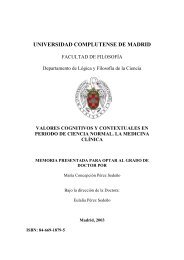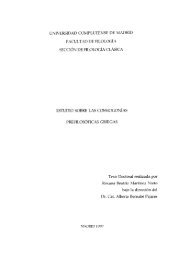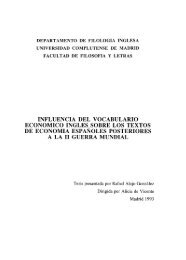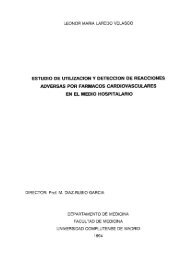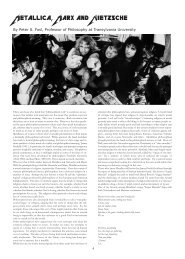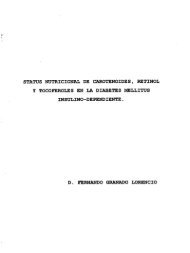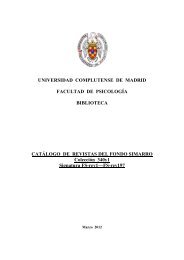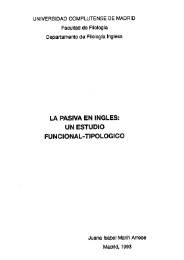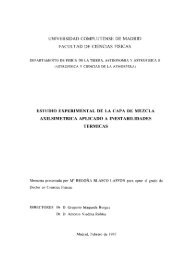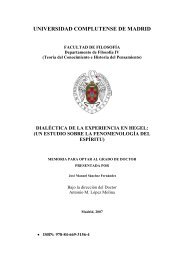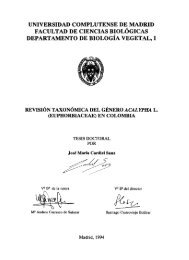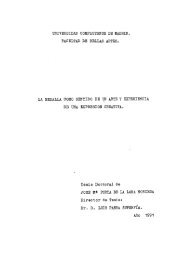UNIVERSIDAD COMPLUTENSE DE MADRID - Biblioteca de la ...
UNIVERSIDAD COMPLUTENSE DE MADRID - Biblioteca de la ...
UNIVERSIDAD COMPLUTENSE DE MADRID - Biblioteca de la ...
You also want an ePaper? Increase the reach of your titles
YUMPU automatically turns print PDFs into web optimized ePapers that Google loves.
a)<br />
b)<br />
5'AE1c<br />
Eduardo Gómez Casado<br />
Material y Métodos 59<br />
Figura 24. Esquema <strong>de</strong> <strong>la</strong>s regiones amplificadas <strong>de</strong> los loci HLA <strong>de</strong> c<strong>la</strong>se I: a) HLA-A y b) HLA-B.<br />
amplificación se muestra en <strong>la</strong> figura 24.<br />
- Todo ello en un volumen final <strong>de</strong> 100 µl.<br />
4.1.3. Reacciones <strong>de</strong> amplificación <strong>de</strong>l DNA.<br />
La mezc<strong>la</strong> <strong>de</strong> reacción <strong>de</strong> PCR para amplificar<br />
HLA-A y -B a partir DNA genómico constaba <strong>de</strong>:<br />
- DNA genómico: 1 µg<br />
- KCl 50 mM<br />
- Tris, pH 8.3, 10 mM<br />
- MgCl2 1.5 mM<br />
- Ge<strong>la</strong>tina 0.01%<br />
- dATP 200 µM<br />
- dCTP 200 µM<br />
- dGTP 200 µM<br />
- dTTP 200 µM<br />
- Primer 5': 1 µM<br />
- Primer 3': 1 µM<br />
- Taq polimerasa, 2.5 Unida<strong>de</strong>s enzimáticas (Perkin<br />
Elmer Cetus, EE.UU).<br />
Es importante seña<strong>la</strong>r que <strong>la</strong> mezc<strong>la</strong> se prepara en su<br />
totalidad excluyendo el DNA y se expone durante 15<br />
minutos con luz ultravioleta a dos longitu<strong>de</strong>s <strong>de</strong> onda:<br />
254 y 302 nm. La irradiación fragmentaría el posible<br />
DNA contaminante, impidiendo que actúe <strong>de</strong> mol<strong>de</strong> en<br />
el proceso <strong>de</strong> amplificación. Las condiciones para <strong>la</strong><br />
amplificación <strong>de</strong> HLA-A y -B que se aplicaron en el<br />
termocic<strong>la</strong>dor PCR-9600 (Perkin Elmer Cetus) fueron:<br />
- Desnaturalización previa a 96ºC durante 1 minuto.<br />
- 4 ciclos <strong>de</strong> <strong>la</strong>s siguientes etapas:<br />
Desnaturalización a 96ºC, 15 segundos.<br />
Hibridación a 72ºC, 45 segundos.<br />
Extensión a 72ºC, 40 segundos.<br />
- 21 ciclos <strong>de</strong> <strong>la</strong>s siguientes etapas:<br />
Desnaturalización a 96ºC, 15 segundos.<br />
Hibridación a 65ºC, 10 segundos.<br />
Extensión a 72ºC, 1 minuto y 10 segundos.<br />
- Extensión final a 72ºC durante 10 minutos.<br />
Tab<strong>la</strong> 4. Oligonucleótidos empleados para <strong>la</strong> amplificación y secuenciación <strong>de</strong> los loci HLA-A y HLA-B<br />
HLA-A<br />
Primer<br />
5'AE1c<br />
3'Ai3c<br />
HLA-B<br />
Primer<br />
5BN1-CG<br />
5BN1-TA<br />
3Bint3-37<br />
EXON 1 INTRON 1<br />
74bp<br />
EXON 1<br />
74bp<br />
5'BN1-TA<br />
5'BN1-CG<br />
129 bp<br />
INTRON 1<br />
129 bp<br />
EXON 2<br />
270 bp<br />
EXON 2<br />
270 bp<br />
Secuencia 5'!3'<br />
CAGACGCCGAGGATGGC<br />
GATCAGGGAGGCGCCCCG<br />
Secuencia 5'!3'<br />
CGGGGGCGCAGGACCCGG<br />
GGCGGGGGCGCAGGACCTGA<br />
AGGCCATCCCCG(G/C)CGACCTAT<br />
INTRON 2<br />
245 bp<br />
EXON 3<br />
276 bp<br />
Localización (pb)<br />
5'UT-Exón 1 (-12 a 5)<br />
Intrón 3 (14 a 31)<br />
Localización (pb)<br />
Intrón 1 (59 a 76)<br />
Intrón 1 (57 a 76)<br />
Intrón 3 (3 a 37)<br />
INTRON 3<br />
3'Ai3c<br />
INTRON 2 EXON 3 INTRON 3<br />
276 bp<br />
245 bp<br />
3'Bint3-37



